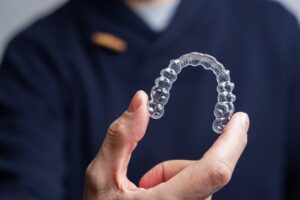
When people think of Invisalign, they often picture straightening crooked teeth without the hassle of metal braces. But what many don’t realize is that Invisalign isn’t just a cosmetic solution – it can also address bite problems that affect your overall oral health. So if you’ve been wondering whether Invisalign can fix your bite, the answer is yes, in many cases, it can. Let’s break down what bite issues are, how Invisalign works to correct them, and whether it might be the right solution for you.
What is a Bite Problem?
A “bite” refers to how your upper and lower teeth come together when your mouth is closed. An ideal bite allows for balanced chewing, clear speech, and less stress on the jaw. When your bite is misaligned, known as a malocclusion, it can lead to a variety of issues, including:
- Jaw pain or clicking (TMJ disorders).
- Headaches.
- Worn-down or chipped teeth.
- Difficulty chewing or speaking.
- Gum recession.
Common types of bite problems include:
- Overbite: Upper front teeth overlap the lower ones too much.
- Underbite: Lower teeth extend past the upper teeth.
- Crossbite: Some upper teeth sit inside the lower teeth.
- Open bite: Teeth don’t touch when the mouth is closed.
- Crowded or spaced teeth: Which can lead to bite imbalance.
Can Invisalign Correct These Issues?
In many cases, yes. Invisalign uses a series of clear, custom-made aligners that gradually shift your teeth into proper position. These aligners are changed every 1 to 2 weeks, with each new set making tiny, controlled movements.
Here’s how Invisalign can help with specific bite problems:
- Overbite and underbite: Invisalign can bring teeth forward or back to create a better bite. In more severe cases, additional attachments or elastics may be used.
- Crossbite: Clear aligners can guide teeth into a proper arch alignment, often preventing uneven wear or gum problems.
- Open bite: By repositioning teeth vertically, Invisalign can close gaps that prevent proper biting.
- Mild to moderate crowding or spacing: Invisalign is highly effective for aligning teeth evenly and creating a balanced bite.
However, not all bite issues can be treated with Invisalign alone. Severe skeletal problems or cases requiring jaw surgery may still need traditional braces or a combination of orthodontic and surgical treatment. The key is getting a professional assessment.
How Long Does Treatment Take?
The length of Invisalign treatment depends on the complexity of your bite. Minor bite issues might be corrected in 6 to 12 months, while more advanced cases could take 18 months or longer. Consistency is key; aligners must be worn 20 to 22 hours a day for optimal results.
Is Invisalign Right for You?
The best way to know is to consult with an experienced Invisalign provider. They’ll assess your bite, take digital scans, and develop a customized treatment plan. With today’s advanced technology and SmartForce attachments, Invisalign can handle more complex cases than ever before.
Invisalign isn’t just for straightening teeth – it’s a powerful tool for correcting many common bite problems. While it may not replace braces in every scenario, it offers a comfortable, discreet, and highly effective solution for a wide range of orthodontic issues. If you’re struggling with bite-related discomfort or simply want to improve your smile and function, Invisalign could be the solution you’ve been waiting for.
About the Practice
Are you considering Invisalign for alignment or bite issues? Here at Waterford Pediatric Dentistry & Orthodontics of Dublin, we can set you on a clear path to a straighter smile. We have no-mess digital impressions and tailor-made treatment plans to meet your unique needs. Plus, we even offer financing to help make your dreams a reality. Schedule your appointment with us online or call us at (925) 803-6880.
